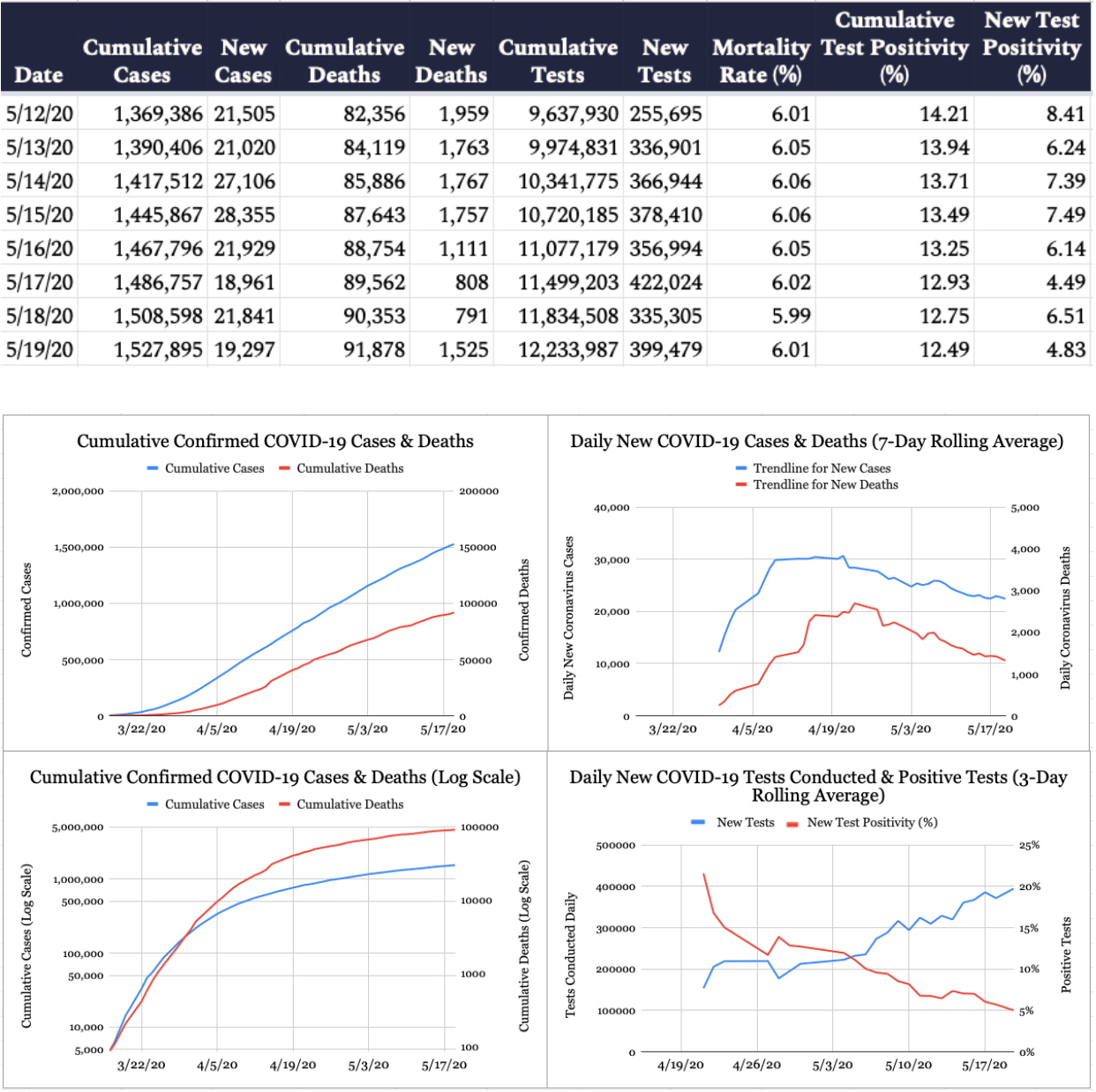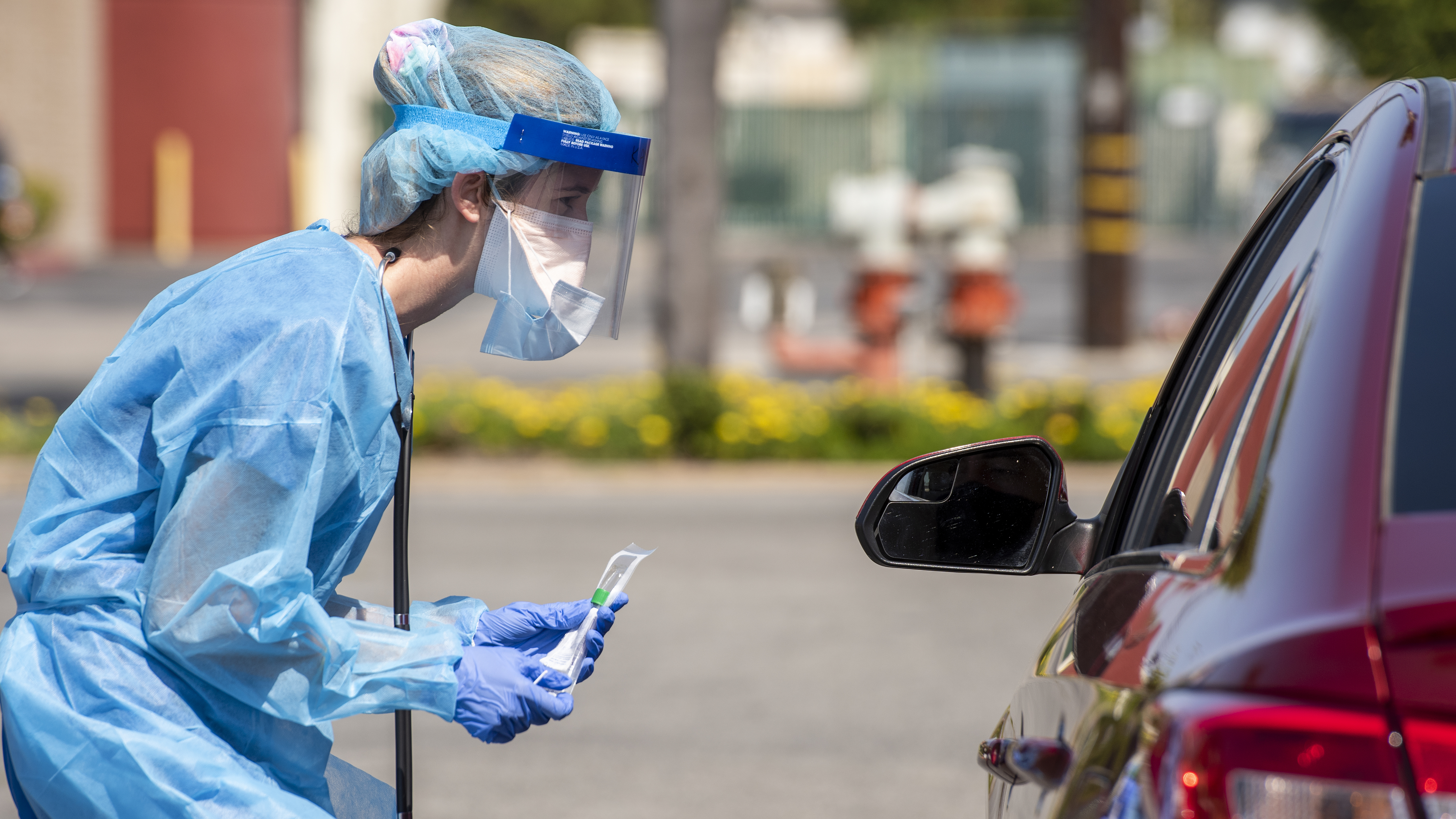Happy Wednesday! We always write this little intro last, and sometimes we finish TMD too late at night for our brains to come up with something witty.
Quick Hits: Today’s Top Stories
-
As of Tuesday night, 1,527,895 cases of COVID-19 have been reported in the United States (an increase of 19,297 from yesterday) and 91,878 deaths have been attributed to the virus (an increase of 1,525 from yesterday), according to the Johns Hopkins University COVID-19 Dashboard, leading to a mortality rate among confirmed cases of 6 percent (the true mortality rate is likely lower, but it’s impossible to determine precisely due to incomplete testing regimens). Of 12,233,987 coronavirus tests conducted in the United States (399,479 conducted since yesterday), 12.5 percent have come back positive.

-
Many recovered COVID-19 patients continue to test positive for the disease long after their symptoms cease, which has caused many experts to worry about the possibility of reinfection. But a new survey out of South Korea finds that such patients aren’t infectious, and are only continuing to shed “dead” virus particles.
-
Another new study performed on hamsters in Hong Kong suggests that masking might reduce coronavirus transmission by as much as 75 percent.
-
The Senate Intelligence Committee voted along party lines to approve the confirmation of Rep. John Ratcliffe as director of national intelligence. The nomination now goes to the full Senate for a vote.
COVID Testing Is Greatly Improved. Is It Enough?

Even as epidemiologists and public health experts insisted that widespread testing was a key to defeating COVID-19, our national testing apparatus was constantly playing catch-up. It was very slow getting off the ground in the first place. Then, it accelerated quickly—but unfortunately, the virus was accelerating faster. By early April, we were processing around 150,000 tests a day, but the test positivity rate, a key metric of how wide-reaching our testing is relative to the pandemic itself, had been rising all the while.
This month, the picture has changed dramatically. The last day we processed fewer than 200,000 tests was April 27; the last day we processed fewer than 300,000 was May 10. Over the last week, we’ve averaged more than 350,000 a day. And that number mostly doesn’t even take into account the serology tests that track not where the virus is, but where it’s been, and which are being deployed in greater and greater numbers across the country. (Cumulative data on serology testing is hard to come by, but one major COVID testing lab, Quest Diagnostics, says it has performed 900,000 such tests since April 27.)
Given that this continued ramp-up in testing has been accompanied by a dip in total new cases thanks to rigorous social distancing, the testing situation is now far rosier than it was just weeks ago. On May 8, we reported that the U.S. had gotten the test positivity rate down from 20 percent to about 16 percent. As of this writing, that rate is just north of 12 percent. This is very, very good news, signaling that we’re making substantial progress toward where we need to be on total test capacity.
Unfortunately, as much as we’ve harped on getting testing up for the past few months, it isn’t everything. What’s just as important as the total number of tests run is ensuring that the correct people are tested—most critically, those who have come in contact with current COVID patients. Figuring out who these people are is the second half of the “test and trace” strategy—and the half that is likely to continue to present difficulties no matter how capacious our raw testing capacity becomes, especially as the economy continues to reopen and social distancing becomes more porous.
Take for example Texas, which is by far the biggest state to have ended its stay-at-home order and begun economic reopening as early as May 1. It also boasts a muscular testing apparatus with a cool 6 percent daily test positivity rate, and has been fortunate enough to avoid any disastrous localized COVID breakouts thus far.
The only difficulty: Texas has not succeeded in flattening its COVID-19 curve. Instead, the rate of new cases has continued to accelerate slowly but steadily over the past month at upward of 1,000 new infections a day.
Why is this, given that Texas is in good shape testing-wise? In part: more testing identifies more cases. But beyond that, contact tracing in a free society is extremely difficult.
How does it work? If you test positive for coronavirus in Texas, the Department of State Health Services will contact you to request you fill out a form detailing the people with whom you’ve likely come in contact in recent days. You are assured that your information will be anonymized, kept completely private: Your contacts will receive word that they may have been exposed to the virus, but the fact that it’s you who exposed them will not be disclosed. You are additionally ensured that your participation is “completely voluntary, and you are not legally required to participate.” If you never get around to filling out the form, your contacts simply won’t be logged—unless and until, of course, they become symptomatic themselves.
Additional bureaucratic difficulties complicate the process. As of today, for instance, the Texas Health Trace contact tracing reporting portal is not yet available in Spanish—a challenge, given that millions of Texans speak only Spanish at home.
These difficulties, of course, are part of the reason why some experts have advocated for America to scale up testing to astronomical levels. If the entire country could be tested for COVID-19 every few weeks, this would theoretically bypass the need to contact-trace altogether. But we’re not there yet.
Worth Your Time
-
Back in January, we pointed you to Dexter Filkins’ unparalleled profile of Iranian general Qassem Suleimani. Yesterday The New Yorker published Filkins’ latest piece on Iran, arguing that amid coronavirus, Ayatollah Khamenei’s regime is being “threatened from within the country.” He writes: “Speculation about Khamenei’s longevity is rampant in the senior levels of government and the military. ‘The struggle to succeed him has already begun,’ my host said. But Khamenei has spent decades placing loyalists throughout the country’s major institutions, building a system that serves and protects him. ‘Khamenei is like the sun, and the solar system orbits around him,’ he told me. ‘This is my worry: What happens when you take the sun out of the solar system? Chaos.’”
-
James Hohmann’s Daily 202 newsletter yesterday did a great job breaking down President Trump’s firing of State Department Inspector General Steve Linick in its entirety and explaining why the president has been able to remove four IGs in the past few weeks with relative impunity. “Of the 53 GOP senators, Mitt Romney is one of only three to publicly express concern about what he called Trump’s ‘unprecedented’ purge of inspectors general,” he writes. “‘Doing so without good cause chills the independence essential to their purpose,’ the 2012 GOP presidential nominee lamented on Saturday night. ‘It is a threat to accountable democracy and a fissure in the constitutional balance of power.’ Trump tweeted what seemed to be a one-word response: ‘LOSER!’”
-
Yesterday’s Morning Dispatch sounded an optimistic note about early trials for a Moderna COVID vaccine. This article from excellent science-journalism publication STAT News offers a few reasons why we should perhaps take that news with a grain of salt.
-
The baseball season may be slowly nearing a return, but its absence has certainly been noticed these past two months—perhaps even more than we expected. We loved this Effectively Wild podcast featuring Ben Lindbergh, Meg Rowley, and Sam Miller talking about their favorite, highly-specific ways to take in a ballgame. From hearing the announcer’s voice crackle on the car radio as you stray out of range on a road trip to staying up for a game on the west coast and falling asleep in front of the TV, there’s nothing quite like the routine of a 162-game baseball season, and we can’t wait to get it back.
Something Fun

(From R.E. Parrish Comics)
Presented Without Comment
Also Presented Without Comment
Also Also Presented Without Comment
Toeing the Company Line
-
Amy Walter, the national editor of the Cook Political Report, joins Jonah on the latest episode of The Remnant for an in-depth discussion of polls, presidential approval ratings, how parties keep coalitions intact, and quality underwear. Tune in here.
-
David has a new French Press out, this one exploring Susan Faludi’s New York Times op-ed arguing that “Believe All Women” is a “right-wing trap” and that the movement merely meant “believe women” all along, without the “all.” And who is to blame for springing this trap? Faludi points an accusatory finger at a tweet from…David French. In response, David deconstructs the claim and leaves her argument in tatters.
-
Eric Trump suggested that coronavirus will “magically all of a sudden go away” after the election in November, a quote the communications director for President Trump’s re-election campaign said was taken out of context. Alec examines both claims in his latest Dispatch Fact Check.
-
On the site today, Samuel J. Abrams dives into the debate over whether colleges should reopen completely or continue with online and virtual learning. He cautions administrators that students aren’t entirely happy with either option and could simply decide not to register for the fall semester.
Let Us Know
One of your Morning Dispatchers—we won’t say which—has been using his quarantine time to rewatch two beloved childhood shows: The Office and Avatar: The Last Airbender. What nostalgic entertainment products, if any, have you been using to fill your excess thumb-twiddling indoor time?
Reporting by Declan Garvey (@declanpgarvey), Andrew Egger (@EggerDC), Sarah Isgur (@whignewtons), Alec Dent (@Alec_Dent), and Steve Hayes (@stephenfhayes).
Photograph by Leonard Ortiz/MediaNews Group/Orange County Register/Getty Images.






Please note that we at The Dispatch hold ourselves, our work, and our commenters to a higher standard than other places on the internet. We welcome comments that foster genuine debate or discussion—including comments critical of us or our work—but responses that include ad hominem attacks on fellow Dispatch members or are intended to stoke fear and anger may be moderated.
You are currently using a limited time guest pass and do not have access to commenting. Consider subscribing to join the conversation.
With your membership, you only have the ability to comment on The Morning Dispatch articles. Consider upgrading to join the conversation everywhere.